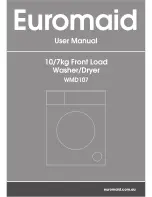
Before washing for the
first time
1. Checking water hardness
In order to achieve good dishwashing results, the dishwasher needs
soft water (water with low mineral content). Hard water leaves a white
coating on dishes and the dishwasher.
Water hardness is specified using the German water hardness scale
(°dH) or the French water hardness scale (°fH).
A water supply with a water hardness in excess of 4°dH (6°fH) must
be softened. This is done automatically with the aid of the built-in water
softener. In order for the water softener to function optimally, it must
be adjusted to the hardness of the water supply. Once you have ad-
justed the water softener, use detergent and rinse aid doses suitable
for soft water.
Contact your local water supplier, or measure the water hardness using
the supplied test strip, to check the water hardness in your area.
How to use the test strip:
1 Turn on the water tap and let the water run for a minute or so.
2 Fill a glass with water.
3 Remove the test strip from its packaging.
4 Dip the test strip in the water for about one second.
5 Wait one minute. Now compare the colours of the squares with the
water hardness table.
°dH
1)
Test strip
°fH
2)
<5
<3
4 green
>7
>4
1 red
>12
>7
2 red
>25
>14
3 red
>37
>21
4 red
Make a note of the water hardness:____________
If the water hardness exceeds 20°dH (36°fH), we recommend connect-
ing an external water softener.
WARNING!
Hard water leaves a white coating on dishes and inside the dishwash-
er. It is therefore important that you select the right setting for the
water softener! See Water hardness.
Never run the dishwasher with an empty salt compartment if the
water supply has a water hardness in excess of 4°dH (6°fH).
2. Basic settings
Open the door and press the main power switch.
"
Welcome to your new ASKO. This is a first time set up.
" is shown
on the display. It is important that you choose the right settings to en-
sure good dishwashing results.
START
STOP
Select setting
Confirm setting
Main power switch
Settings
Language
1
Select the language to be shown on the display.
Rinse aid
0/1/2/3/4/5/TAB
2
By using rinse aid you will improve your drying result. You will also
achieve a better dishwashing result with glassware and dishes.
Select rinse aid dosage. The rinse aid dispenser can be adjusted
between 0 (Off) and 5 (High dosage).
When using an all-in-one detergent that contains rinse aid, you can
activate the setting TAB. Read more about all-in-one detergent in the
chapter Using the dishwasher.
Pre-selected at factory: 5
Top up rinse aid
Press to open
1 Open the rinse aid compartment lid.
2 Carefully top up with rinse aid to the level marked
max
.
3 Wipe up any splashes of rinse aid around the compartment.
4 Close the lid firmly.
1)
German water hardness scale
2)
French water hardness scale
4
Содержание DWCBI241
Страница 1: ...Dishwasher DWCBI241 OPERATING INSTRUCTIONS EN...
Страница 25: ...Your notes 25...
Страница 26: ...Your notes 26...
Страница 27: ...Your notes 27...





































